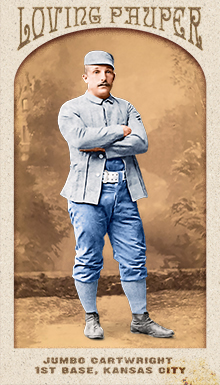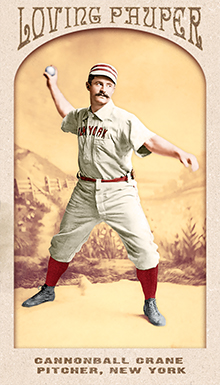
- Series: 1880s: Loving Paupers
- City: Kansas City
- Team: Blues (WA)
- League: Western Association
Edward Charles Cartwright (1859-1933) was built to anchor first base and, once he finally made it to the majors at age 30, he did just that; first for the Browns in 1890 and then for four straight seasons with the Washington Senators of the National League from '94-97. The stocky 5'10” 220 lb infielder hit well until his final season, better than he had in the minors. His rookie year saw him hit .300 while driving in 60 runs. After a three-year hiatus, he continued his excellent offense, highlighted by a .331 average in 1895. He carried his weight well, evidenced by the fact he still ranks 13th all-time among base stealers who played for D.C. teams. Jumbo began with Youngstown in 1883 and had one season -1886- with the Acid Iron Earths in Mobile for the Gulf League, one of the more intriguingly-named clubs in the universe of minor league baseball that had some doozies. He was with New Orleans in '87 then Kansas City and St. Joseph (another of those tantalizingly-dubbed clubs-the Clay Eaters) before heading north to Montreal in the International Association to begin the 1890 campaign prior to his call to St. Louis for his MLB debut. Despite hitting .300 in 75 games for the Browns, Ed was sent west where he played for San Francisco, Tacoma and Missoula before returning closer to home with Memphis for the '93 season. He was released by the Senators in mid-1897 and played a few more games with the Minneapolis Millers as his pro career came to an end.
- Jumbo had a game whose output at the plate justified his nickname. On September 23, 1890 he drove in seven runs in one inning, setting a mark that would stand for 109 years until another St. Louis warrior, Cardinal Fernando Tatís, hit two grand slams off the Dodgers' Chan Ho Park in the third inning on April 23, 1999
Auction History
Cartophilia
Old Judge Pose: 70-1

- Series: 1880s: Loving Paupers
- City: Chicago
- Team: White Stockings
- League: National League
- Hall: National Baseball Hall of Fame
John Gibson Clarkson (1861-1909) won 328 games, won the triple crown in 1889 and twice pitched more than 600 innings in a season. In 1885, John appeared in 70 games, threw 68 complete games, 623 innings, won 53, had an ERA of 1.85, a no-hitter, and won the pennant. Apparently having to hurl the sphere a mere fifty feet was a tonic to the arm. But unlike so many pitchers of his era, Clarkson didn’t flame out from such prodigious labor on the mound. From 1885-92 he AVERAGED 36 wins per season and would win 30+ an extraordinary six times. This great career began with the Worcester Ruby Legs in 1882, flowered with Cap Anson’s Sox in ‘84 and fully bloomed in Boston when John followed his ace catcher King Kelly to the Beaneaters in ‘88. League politics that culminated in the Players’ League revolt took a toll on Clarkson’s reputation and sundered his friendship with Kelly as the hurler remained loyal to the Nationals.
- Cleveland acquired John in 1892 allowing him to team with Cy Young. Chief Zimmer, who caught Young for a decade, proclaimed Clarkson the best he ever saw
- Elected to Hall of Fame: 1963
Auction History
Cartophilia
Old Judge Pose: 78-7

- Series: 1880s: Loving Paupers
- City: New York
- Team: Giants
- League: National League
Elmer Ellsworth Cleveland (1862-1913) was a third baseman and shortstop who was a good enough hitter to carve out a very respectable pro career, principally in the minors. He began with Johnstown of the Western Interstate League in 1883 and, as so many of his talent and age, got a chance at the “big leagues” the following season with the Cincinnati Outlaw Reds, the aptly-named club in the upstart Union Association. Elmer actually had a great season for Cincy playing against other mostly minor league talent. He hit .322 in 29 games. His limitations as a hitter caught up to him in his future appearances with major league teams. He next came up with the New York Giants in 1888, getting into nine games before being shipped to Pittsburgh's Alleghenys where he got into 30 games. His combined average tumbled to .235. Cleveland got one more shot, with the Columbus Solons of the American Association in 1891 where his miserable .171 average signaled the end of any dreams of big league glory. Nevertheless, he stayed in minor league baseball through his twenties, finally calling it quits after playing the 1892 season back in Johnstown with the Pirates, now in the Pennsylvania State League and finishing up the year with Danville in the same circuit. His opponents that year included the Wilkes-Barre Coal Barons, the Reading Actives and the Lebanon Pretzel Eaters.
- Cleveland must have cut an imposing figure in that era, standing 5'11” and tipping the scales at 190 lbs. However, the sturdy third baseman learned the unfortunate consequences of not hitting one's weight
Auction History
Cartophilia
Old Judge Pose: 80-2

- Series: 1880s: Loving Paupers
- City: New York
- Team: Giants
- League: National League
- Hall: National Baseball Hall of Fame
Roger Connor (1857-1931) was the home run king of the 19th century, clouting 138 in his 18-year career. His record stood for 23 years after his retirement, until Babe Ruth surpassed him in 1921. Connor anchored first-base for five teams, winning pennants twice with the Giants. His flair for the dramatic was never more evident than when he struck the first-ever major league grand slam with his team down by three with two outs in the ninth. Born in Connecticut, Roger played for local clubs until joining the Troy Trojans in 1880. That NY hamlet witnessed five future Hall of Famers on their squad with Connor playing alongside Dan Brouthers, Buck Ewing, Tim Keefe and Mickey Welch. After moving to the Gothams, the 6’3” Connor inspired owner Jim Mutrie to proclaim the team “my giants!” and a new identity was born.
- Much more than a slugger, Connor won the NL batting title in 1885 and consistently hit .300+ while exhibiting remarkable speed for a big man (still fifth all-time in triples)
- Connor lived to see Ruth claim his HR title. It was thought at the time, however, that Connor had hit 131 HRS and Ruth's record was celebrated at 132. Writing for SABR in 1975, John tattersall discovered that Connor had actually hit 138 HRs.
- Jay Jaffe's JAWS system ranks Connor as the 5th greatest 1st baseman of all-time, just behind Cap Anson and just ahead of Jeff Bagwell
- Beloved by fans and the baseball press, he had a particularly strong advocate for the Hall in fellow legend, umpire Bill Klem
- Elected to Hall of Fame: 1976
Auction History
Cartophilia
Old Judge Pose: 88-3

- Series: 1880s: Loving Paupers
- City: New York
- Team: Giants
- League: National League
Edward Nicholas Crane (1862-1896) began in major league ball with the notorious Boston Reds of the Union Association - a hard-drinking crew. It appears that big Ed avoided the bottle that would eventually kill him years later when he joined Al Spalding’s world exhibition tour. That he even made that trip was highly unlikely as Cannonball had labored in anonymity for years until the 1889 “World Series,” where Jim Mutrie played a hunch and decided his Giants could best the Bridegrooms with fastballs. Crane was tapped for five starts, won four and the Series. Cannonball could always throw hard and was famed for a 406’ long-toss, but such post-season heroics were virtually unheard of. The seeds of Ed’s doom had been planted on that tour however, nourished by the vices of Paris. All too soon he would spiral into alcoholism and an early death. While the coroner ruled Crane's death an accidental overdose, rumors persisted that he had taken his own life by drinking acid.
- Ed had one of the great seasons of any pitcher for the Toronto Maple Leafs in ‘87 with 33 wins and an eye-popping .428 BA (when walks counted as hits)
- Other firsts: 1st NY Giant to hurl no-hitter; 1st pitcher with four Ks in an inning
Auction History
Cartophilia
Old Judge Pose: 96-6




